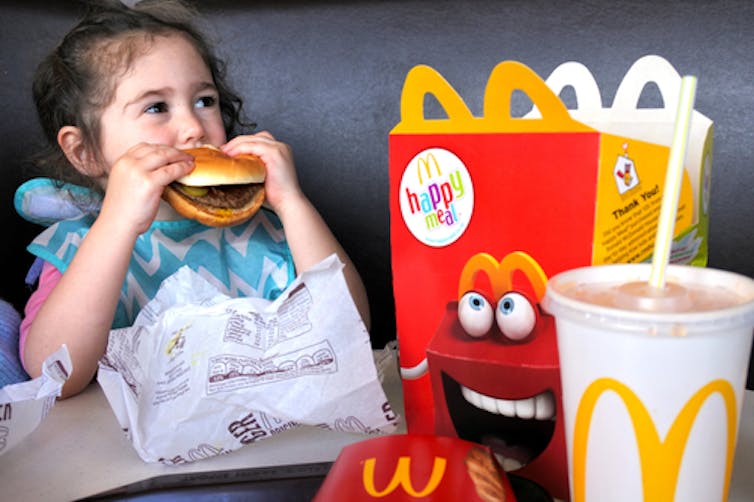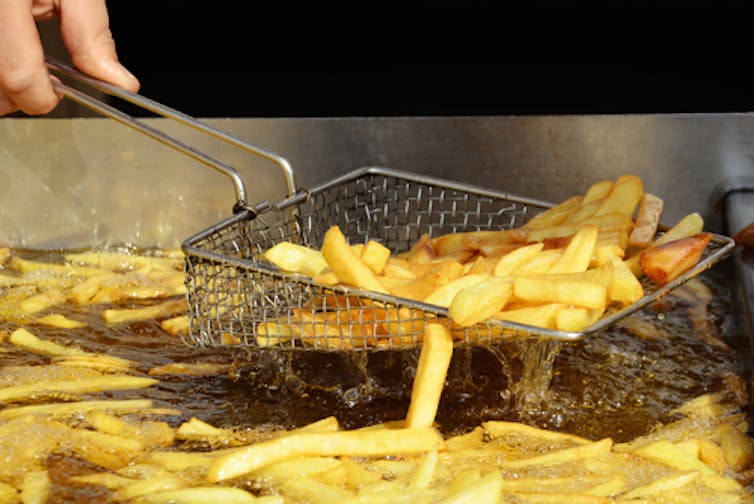AP Photo/Rogello V. Solis
Jennifer Harris, University of Connecticut
McDonald’s recently announced a major commitment to improve the nutrition quality of its kids’ meals. Globally, at least 50 percent of Happy Meal bundles, which include a main dish, side and drink, will meet nutrition limits on calories, saturated fat, added sugar and sodium set by McDonald’s. In the U.S., the restaurant will use strategies such as not listing cheeseburgers or chocolate milk on Happy Meal menus – but providing the items if customers ask – to meet this goal.
This commitment is a positive step, but reducing children’s consumption of nutritionally poor fast food will require much more.
I have spent 10 years studying fast-food kids’ meals marketing and nutrition. My research and that of others demonstrate an enormous challenge for parents to select healthy options when the environment inside fast-food restaurants makes the unhealthy options so much more appealing.
Fast food: Children are lovin’ it
Improving the nutrition of fast-food kids’ meals is important to public health. Childhood obesity rates have skyrocketed over the past four decades, with no improvement in recent years. In the U.S., 58 percent of children ages 6 to 8 and 41 percent of preschoolers are overweight or obese.
Sugary drinks are a big problem, but so is fast food. Despite recent introductions of healthier items, nearly all fast-food items, including on kids’ meal menus, exceed recommendations for maximum calories, sugar, saturated fat and/or sodium in a meal for children. Fewer than 3 percent of kids’ meal bundles offered by top fast-food restaurants, including McDonald’s, meet the industry’s own standards – set by the National Restaurant Association – for healthy meals for kids.
Furthermore, on any day, one-third of children consume fast food. And on days they eat fast food, children consume 126 additional calories, and more sugar, saturated fat and sodium.
Support for mandating healthier kids’ meals is growing, as local communities enact laws setting nutrition standards for kids’ meals. The Baltimore City Council just approved legislation requiring healthy drinks as the default in kids’ meals, following the lead of other cities, including Davis, California, and Lafayette, Colorado.
Over the past five years, McDonald’s has done more than most fast-food restaurants to voluntarily improve the nutritional quality of its kids’ meals. In 2013, it reduced the size of french fries in Happy Meals and added a healthier side, such as apple slices or yogurt. In 2014, the restaurant initiated a policy to remove sugary sodas from kids’ meal menus and only list healthier drinks, including milk, chocolate milk and 100 percent juice as options.
McDonald’s also has more at stake. The company spent US$33 million advertising Happy Meals in 2016. Children aged 2 to 5 viewed, on average, 2.7 TV ads for Happy Meals each week, while 6- to 11-year-olds saw three ads. Notably, children saw more ads for McDonald’s Happy Meals than for any other food brand in 2016, and the company placed more than 10 times as many ads on children’s TV networks (e.g., Nickelodeon or Cartoon Network) than any other fast-food restaurant.
This marketing works. In a survey of parents, 41 percent said their child asked to go to McDonald’s at least once a week, while 15 percent of parents of preschoolers reported that their child asked to go every day.

ChameleonsEye/Shutterstock.com
Persuading parents to say “yes” to their children’s requests is also part of McDonald’s marketing strategy. When advertising to parents, trips to McDonald’s and Happy Meals become a way to make children and parents happy. Public relations campaigns announcing nutritious options in Happy Meals also support this strategy. In a recent survey that has not yet been published, my research group found that 80 percent of parents said they had purchased lunch or dinner for their children under age 12 from McDonald’s in the past week. And two-thirds said they would take their child to McDonald’s more often because of the restaurant’s healthier kids’ meal policies.
Yet despite positive attitudes about healthier Happy Meals, unhealthy sides and drinks with Happy Meals persist. In our 2016 survey, we asked parents who reported purchasing a Happy Meal for their child what drink they received; 42 percent answered that they received a soda. This proportion has not changed since 2010. In addition, 64 percent reported that they received french fries, while 31 percent did not receive a healthy side. (Happy Meals come with two sides.) Furthermore, 18 percent of parents purchased an item, such as dessert, plus the Happy Meal for their child, and 25 percent did not purchase a kids’ meal at all. Notably, parents were more likely to purchase Happy Meals and healthier drinks for preschoolers than for older children.
The tantalizing smell of fries

Whiteaster/Shutterstock.com
Parents decide whether their child gets apple slices and milk or french fries and soda with Happy Meals. But research on consumer choices shows that making the healthy choice in this situation is difficult, even for adults. Consider the environment inside a fast-food restaurant: the smell of french fries, the prominent soda fountain with soda brand logos, the images of ice cream and large burgers on posters and menu boards. These cues all trigger desire for these unhealthy but highly appetizing choices.
Studies by behavioral economists also show that simply offering healthy options alongside unhealthy options is not enough to increase consumers’ selection of healthy option.
However, offering healthier drinks and sides by default – and only providing unhealthy options upon consumer request – significantly increases the likelihood that consumers will accept the healthy items. Disney theme parks use this approach with their kids’ meals. An evaluation of their policy demonstrated high acceptance of healthier options.
Publicizing healthier Happy Meal options while also offering unhealthy options raises concerns about potential “health halo” effects. Research has shown that depicting more nutritious kids’ meal items in fast-food commercials does not increase children’s selection of healthier items, but it does increase their reported liking of fast food generally. Advertising for unhealthy food, such as cookies and fruit drinks, using nutrition messages increases children’s beliefs that these products are healthy. Studies with adults have also shown increased calorie consumption and purchases of unhealthy fast-food sides resulting from health halo marketing messages.
Finally, a recent evaluation of McDonald’s healthier kids’ meal side and drink policies revealed inconsistent implementation at individual restaurants. In some cases, menu boards still showed french fries and sugary drinks as kids’ meal options, and counter personnel continued to suggest these items with kids’ meal orders.
![]() McDonald’s new commitment to set nutrition standards for Happy Meal bundles is a positive first step. However, I believe the restaurant must do more to prove its commitment to children’s health and supporting parents. Healthy Happy Meals should be the most appealing choice for children, the most convenient choice for parents, and the only Happy Meal options available at their restaurants. McDonald’s could also, in my view, stop advertising directly to children as young as 2 years old so that parents can make the decision about if and when to introduce their children to McDonald’s.
McDonald’s new commitment to set nutrition standards for Happy Meal bundles is a positive first step. However, I believe the restaurant must do more to prove its commitment to children’s health and supporting parents. Healthy Happy Meals should be the most appealing choice for children, the most convenient choice for parents, and the only Happy Meal options available at their restaurants. McDonald’s could also, in my view, stop advertising directly to children as young as 2 years old so that parents can make the decision about if and when to introduce their children to McDonald’s.
Jennifer Harris, Professor of Allied Health Sciences, University of Connecticut
This article was originally published on The Conversation. Read the original article.

